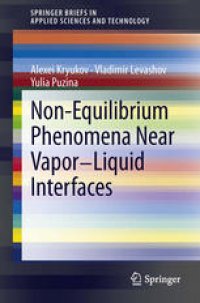
Ebook: Non-Equilibrium Phenomena near Vapor-Liquid Interfaces
- Tags: Engineering Thermodynamics Heat and Mass Transfer, Nuclear Engineering, Engineering Fluid Dynamics
- Series: SpringerBriefs in Applied Sciences and Technology
- Year: 2013
- Publisher: Springer International Publishing
- Edition: 1
- Language: English
- pdf
This book presents information on the development of a non-equilibrium approach to the study of heat and mass transfer problems using vapor-liquid interfaces, and demonstrates its application to a broad range of problems. In the process, the following peculiarities become apparent: 1. At vapor condensation on the interface from gas-vapor mixture, non-condensable components can lock up the interface surface and condensation stops completely. 2. At the evolution of vapor film on the heater in superfluid helium (He-II), the boiling mass flux density from the vapor-liquid interface is effectively zero at the macroscopic scale. 3. In problems concerning the motion of He-II bridges inside capillaries filled by vapor, in the presence of axial heat flux the He-II bridge cannot move from the heater as would a traditional liquid, but in the opposite direction instead. Thus the heater attracts the superfluid helium bridge. 4. The shape of liquid-vapor interface at film boiling on the axis-symmetric heaters immersed in liquid greatly depends on heat flux in the interface. Thus a new type of hydrostatic problems appears when in contrast to traditional statements the shape of the liquid-vapor interface has a complex profile with a point of inflection and a smooth exit on a free liquid surface.
This book presents information on the development of a non-equilibrium approach to the study of heat and mass transfer problems using vapor-liquid interfaces, and demonstrates its application to a broad range of problems. In the process, the following peculiarities become apparent: 1. At vapor condensation on the interface from gas-vapor mixture, non-condensable components can lock up the interface surface and condensation stops completely. 2. At the evolution of vapor film on the heater in superfluid helium (He-II), the boiling mass flux density from the vapor-liquid interface is effectively zero at the macroscopic scale. 3. In problems concerning the motion of He-II bridges inside capillaries filled by vapor, in the presence of axial heat flux the He-II bridge cannot move from the heater as would a traditional liquid, but in the opposite direction instead. Thus the heater attracts the superfluid helium bridge. 4. The shape of liquid-vapor interface at film boiling on the axis-symmetric heaters immersed in liquid greatly depends on heat flux in the interface. Thus a new type of hydrostatic problems appears when in contrast to traditional statements the shape of the liquid-vapor interface has a complex profile with a point of inflection and a smooth exit on a free liquid surface.
This book presents information on the development of a non-equilibrium approach to the study of heat and mass transfer problems using vapor-liquid interfaces, and demonstrates its application to a broad range of problems. In the process, the following peculiarities become apparent: 1. At vapor condensation on the interface from gas-vapor mixture, non-condensable components can lock up the interface surface and condensation stops completely. 2. At the evolution of vapor film on the heater in superfluid helium (He-II), the boiling mass flux density from the vapor-liquid interface is effectively zero at the macroscopic scale. 3. In problems concerning the motion of He-II bridges inside capillaries filled by vapor, in the presence of axial heat flux the He-II bridge cannot move from the heater as would a traditional liquid, but in the opposite direction instead. Thus the heater attracts the superfluid helium bridge. 4. The shape of liquid-vapor interface at film boiling on the axis-symmetric heaters immersed in liquid greatly depends on heat flux in the interface. Thus a new type of hydrostatic problems appears when in contrast to traditional statements the shape of the liquid-vapor interface has a complex profile with a point of inflection and a smooth exit on a free liquid surface.
Content:
Front Matter....Pages i-x
Introduction....Pages 1-1
Background for Pure (One Component) Substance....Pages 3-7
Evaporation and Condensation of Vapor–Gas Mixtures....Pages 9-23
Motion of Vapor–Liquid Interfaces....Pages 25-40
Liquid–Vapor Interface Form Determination....Pages 41-51
Summary....Pages 53-54
This book presents information on the development of a non-equilibrium approach to the study of heat and mass transfer problems using vapor-liquid interfaces, and demonstrates its application to a broad range of problems. In the process, the following peculiarities become apparent: 1. At vapor condensation on the interface from gas-vapor mixture, non-condensable components can lock up the interface surface and condensation stops completely. 2. At the evolution of vapor film on the heater in superfluid helium (He-II), the boiling mass flux density from the vapor-liquid interface is effectively zero at the macroscopic scale. 3. In problems concerning the motion of He-II bridges inside capillaries filled by vapor, in the presence of axial heat flux the He-II bridge cannot move from the heater as would a traditional liquid, but in the opposite direction instead. Thus the heater attracts the superfluid helium bridge. 4. The shape of liquid-vapor interface at film boiling on the axis-symmetric heaters immersed in liquid greatly depends on heat flux in the interface. Thus a new type of hydrostatic problems appears when in contrast to traditional statements the shape of the liquid-vapor interface has a complex profile with a point of inflection and a smooth exit on a free liquid surface.
Content:
Front Matter....Pages i-x
Introduction....Pages 1-1
Background for Pure (One Component) Substance....Pages 3-7
Evaporation and Condensation of Vapor–Gas Mixtures....Pages 9-23
Motion of Vapor–Liquid Interfaces....Pages 25-40
Liquid–Vapor Interface Form Determination....Pages 41-51
Summary....Pages 53-54
....